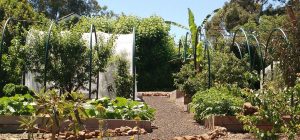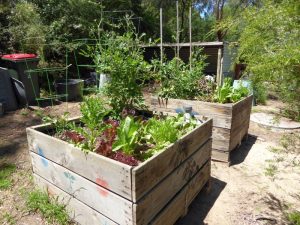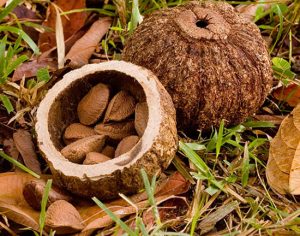Helen Simpson interviews Guy and Susan Palmer
 For her swansong, Helen decided to interview my wife and I. Here is how Helen introduces her write up: “Susan greets me with a cheery welcome as I arrive at the front gate and walk through to Guy and Susan’s well-designed, splendidly looked-after and large Eltham garden. There’s plenty to admire on our way to the front door – meandering gravel paths with dry stone edges, wonderful garden art, well-kept native plants and an extensive ‘orchard’ of well-pruned fruit trees basking in the sun.” Read the full interview.
For her swansong, Helen decided to interview my wife and I. Here is how Helen introduces her write up: “Susan greets me with a cheery welcome as I arrive at the front gate and walk through to Guy and Susan’s well-designed, splendidly looked-after and large Eltham garden. There’s plenty to admire on our way to the front door – meandering gravel paths with dry stone edges, wonderful garden art, well-kept native plants and an extensive ‘orchard’ of well-pruned fruit trees basking in the sun.” Read the full interview.
Once again, I’d like to thank Helen for all her efforts: her growing guides are among the most popular of our website pages and her home grower interviews have been widely acclaimed. She has also been great to work with, in part because of her reliability and collegiate approach.
We are still (desperately!) looking for more people who are willing to be interviewed. If you are potentially willing, email us.
What seeds to plant in December
Here is a list (see the planting guide for more detail):
Warm season veggiesBeans |
Perennial herbsOregano |
Other veggies and herbsAsparagus |
December is not a good planting month: (arguably) too late for most summer veggies and, although you can plant leafy greens such as lettuce and mustard greens, they are likely to go to seed pretty quickly.
Mac’s tip of the week
“Remember to train your tomatoes! Now that they are growing fast, you will need to tie them about every 20cm of growth. As they are starting to flower as well, best to tie loosely above the cluster of flowers. If you have single stakes, and planted close together, best to train to a single stem. This means pinching out side stems (aka branches) that are growing in the crotches between the leaves and the main stem. If you have a cage or trellis, or have spaced wide apart to allow more support stakes, allow maybe four main stems but pinch out further side stems. Older heirloom varieties often do better with multiple stems rather than a single. By training you will not only get a tidier plant, but also less fungal problems and quicker fruit, as your plants put more energy in to flowers and fruiting rather than to stem and leaf growth. Potassium is a key to success and liquid tomato food is full of it, as is sulphate of potash.”
My Green Garden’s take on tomato pruning from a few weeks ago: as your seedlings get bigger, you need to decide whether to prune out the laterals or leave them to grow. The answer to the question will determine how many tomatoes you end up with (don’t prune = more); the size of the tomatoes (do prune = larger); and whether or not you are prepared to use several stakes for each plant (don’t prune = more supports needed). Also, the laterals pruned out can be rooted in water to create another plant if you need one.
Also, read Helen Simpson’s guide on how to grow tomatoes.
Ever wondered what happened to the Eltham Farmers’ Market wicking beds?
 I’ve managed to track down 2 of the 4 beds and they certainly have found a good home: newsletter reader Nada Cunningham has upgraded and incorporated them into her veggie patch and is currently growing lettuce, tomatoes and other veggies in them.
I’ve managed to track down 2 of the 4 beds and they certainly have found a good home: newsletter reader Nada Cunningham has upgraded and incorporated them into her veggie patch and is currently growing lettuce, tomatoes and other veggies in them.
The first results of the great garlic experiment are in!
In the 12th April newsletter, there was a discussion about the right time to plant garlic. Garlic is usually planted in April but, this year, some people thought that the soil was still too warm and thus that planning should be deferred. We decided to run a controlled experiment, the first results for which are now available.
The first results relate to Monaro Purple hardnecks. Rows of garlic were planted two weeks apart over an 8-week period from mid April to mid June. In addition, some garlic was kept in the fridge for 40 days from mid April and then planted. All the plants died back at the same time (second half of November) and were harvested on 24th November. The key results were:
- The April plantings produced a normal number of normal-sized garlics with normal cloves.
- The May plantings produced the same results as the April plantings but in a bit less time.
- The non-refrigerated June plantings produced much smaller bulbs, half of which were not divided into cloves.
- The refrigerated June plantings (perhaps surprisingly) produced the same results as the April and May plantings.
I asked farmers Warren McKimmie, from Strathewen-based Sugarloaf Produce, and Mark Sherwin, from Montmorency-based The Mushroom Shed, what they thought of the results. Neither was surprised.
The conclusion: continue to plant your garlic in April or May even if the weather is warm. If you forget, try putting your garlic into the fridge for a bit before planting.
Have you got gall wasp?
In July, Leaf, Root & Fruit, from Hawthorn East, blogged about an experiment they are conducting on an alternative approach to treating citrus gall wasp. They have now written a Facebook post which requests people with infested trees to post photos of their infestation.
Want to learn more about bush foods?
Bush Foods and Survival Plants of South East Australia is an upcoming book which you can effectively pre-order at the Pozible website for $40.
Bush foods & herbs for courtyards & balconies is a presentation by Karen Sutherland at Bulleen Art & Garden on Thursday, 7th December.
Newsletter reader Julie Merlet sells Australian native fruits, herbs and spices online on her website. The products include davidson plum, desert lime, kakadu plum, aniseed myrtle, bush tomato, lemon myrtle, mountain pepperleaf, pepperberries, peppermint gum, quandong, riberry/lillipilli, rivermint, saltbush, sea parsley, strawberry gum and wattleseed.
Local food producers in the news
Yarra Coffee, from Lilydale, won a silver medal in the ‘organic (expresso)’ category of the 2017 Golden Bean awards. Quists Coffee, from Research, won a bronze medal in the ‘milk based’ category. Readers with a good memory may remember that Quists were inducted into the Australian Coffee Roasters Hall of Fame in 2016.
‘Crowd harvest’ – seeds for Christmas
Gardeners everywhere often harvest more seeds than they can sensibly store. Gardeners with excess seeds are invited to send them in a Christmas card or holiday card to one or more not-for profit organisations listed below, each of which has a certified horticulturalist employed and ready to look after the seeds, either to start the seeds, store the seeds or distribute to others in need who know how to start seeds. Asylum Seeker Resource Centre in Footscray, DIVRS in Preston, STREAT in Collingwood or Carrington Health in Box Hill (ask for Alex Salmon). Any questions, contact Cath Lyons (aka Tiny Trowel) by phone (0401 814679) or email.
A simple, but illuminating, experiment
 See a science experiment on soil erosion, which demonstrates the relationship between precipitation, soil erosion, protection of watercourses and vegetation.
See a science experiment on soil erosion, which demonstrates the relationship between precipitation, soil erosion, protection of watercourses and vegetation.
Every newsletter needs a good picture – brazil nuts
 The flower of a brazil nut tree can only be pollinated by an insect strong enough to lift the coiled hood and with tongues long enough to negotiate the complex coiled flower. In practice, this means the female long-tongued orchid bee.
The flower of a brazil nut tree can only be pollinated by an insect strong enough to lift the coiled hood and with tongues long enough to negotiate the complex coiled flower. In practice, this means the female long-tongued orchid bee.
Bees only exist where they can mate. So, the smaller male bees are also required. But they are only attracted by a certain type of orchid. So, the tree needs to be in the presence of that orchid.
The tree’s fruit is actually the size of a coconut and the brazil nuts are seeds rather than nuts (8-24 within a single fruit). So, the fruit needs to be cracked open and this requires a large rodent (i.e. an agouti).
So propagation of brazil nuts requires agoutis, orchids and strong, long-tongued bees.
Which link was clicked most times in last week’s newsletter?
Judy Vizzari’s interview with Evan Gellert.
Proverb of the month
The moon is made of green cheese. Meaning: a complete impossibility; the same as when pigs can fly or when Hell freezes over. These are all ‘adynatons’, which is where a hyperbole is magnified to such an extent that it is totally infeasible. Note that the phrase ‘green cheese’ refers to ‘young cheese’ rather than to the colour green. So, perhaps more technically correct is the moon is made of cream cheese. The reference is to a simple soul who sees a reflection of the moon in water and mistakes it for a round cheese wheel.
The phrase was originally formulated in 1546 by a man called John Heywood. Mr. Heywood apparently made his living, at least in part, by collecting/inventing proverbs, including: out of sight, out of mind; look before you leap; two heads are better than one; beggars can’t be choosers; all’s well that ends well; the fat is in the fire; I know which side my bread is buttered on; a penny for your thoughts; Rome was not built in a day; better late than never; the more the merrier; you can’t see the wood for the trees; don’t look a gift horse in the mouth; and you can’t have your cake and eat it.
Quote of the month
“Do not spread the compost on the weeds.” by William Shakespeare (in Hamlet).
Joke of the week
Why did the doughnut go to the dentist? Because it needed a chocolate filling.
New events
Cooking master class
What: Enjoy 3 tasting size courses cooked by chef Bek McMillan, from Gourmet Living, who will demonstrate step by step. All recipes are included. Menu: beetroot & brie bruschetta; gnocchi; and Christmas mousse.
When: Thursday, 7th December, 7-9pm.
Where: Gourmet Living, Templestowe.
Cost: $42.
Further information: LFC calendar entry.
Cooking master class
What: Enjoy 3 tasting size courses cooked by chef Bek McMillan, from Gourmet Living, who will demonstrate step by step. All recipes are included. Menu: tomato & goats cheese tart; tangy tamarind prawns; and Christmas Eton mess.
When: Thursday, 14th December, 7-9pm.
Where: Gourmet Living, Templestowe.
Cost: $42.
Bookings: Eventbrite.
Further information: LFC calendar entry.
Summary of upcoming events
Over the next week
- Dehydrating your summer fruit and vegetables: Wednesday, 29th November, 6-7pm.
- Summer harvest: Wednesday, 29th November, 7-9pm.
- Gourmet guests at Eastland – Diana Chan: Thursday, 30th November, 10am-midday.
- Cooking master class: Thursday, 30th November, 7-9pm.
- Mushrooms to mushrooms workshop: Friday, 1st December, 10am-12.30pm.
- Preserving basics – making preserves for Christmas: Friday, 1st December, 10am-1.30pm.
- Summer fruit tree maintenance: Saturday, 2nd December, 9.30am-12.30pm.
- Summer pruning workshop: Saturday, 2nd December, 10am-1pm.
- Preserving basics – making preserves for Christmas: Saturday, 2nd December, 10am-1.30pm.
- Healing the gut: Saturday, 2nd December, 11am-midday.
- Food, family, culture – Vietnamese coffee: Saturday, 2nd December, 2.30-3.30pm.
- Growing avocados and other subtropical and tropical fruit: Sunday, 3rd December, 2.30-3.30pm.
- Grafting workshop: Sunday, 3rd December, 3.30-4.30pm.
- Christmas cake decorating: Monday, 4th December, 10.30-11.30am.
- Food know how sustainability sessions – Plan, Buy, Cook presents preparing for the holiday season: Tuesday, 5th December, 11am-midday.
- Plan, buy, cook – how to avoid food waste this Christmas: Wednesday, 6th December, 6.30-8.30pm.
Over the next month
- Christmas cupcake decorating: Thursday, 7th December, 1-4pm.
- Bush foods & herbs for courtyards & balconies: Thursday, 7th December, 6.30-9pm.
- Cooking master class: Thursday, 7th December, 7-9pm.
- Humanscape – therapeutic horticulture in the workplace: Friday, 8th December, 9am-4pm.
- Raw living whole foods with Valentina Rise: Saturday, 9th December, 3-6pm.
- Cooking master class: Thursday, 14th December, 7-9pm.
- Indigenous plants for food and medicine: Saturday, 16th December, 9.30am-12.30pm.
- Veggie patch 101: Sunday, 17th December, 10am-12,30pm.
- Gourmet guests at Eastland – Justine Schofield: Thursday, 28th December, 10am-midday.
